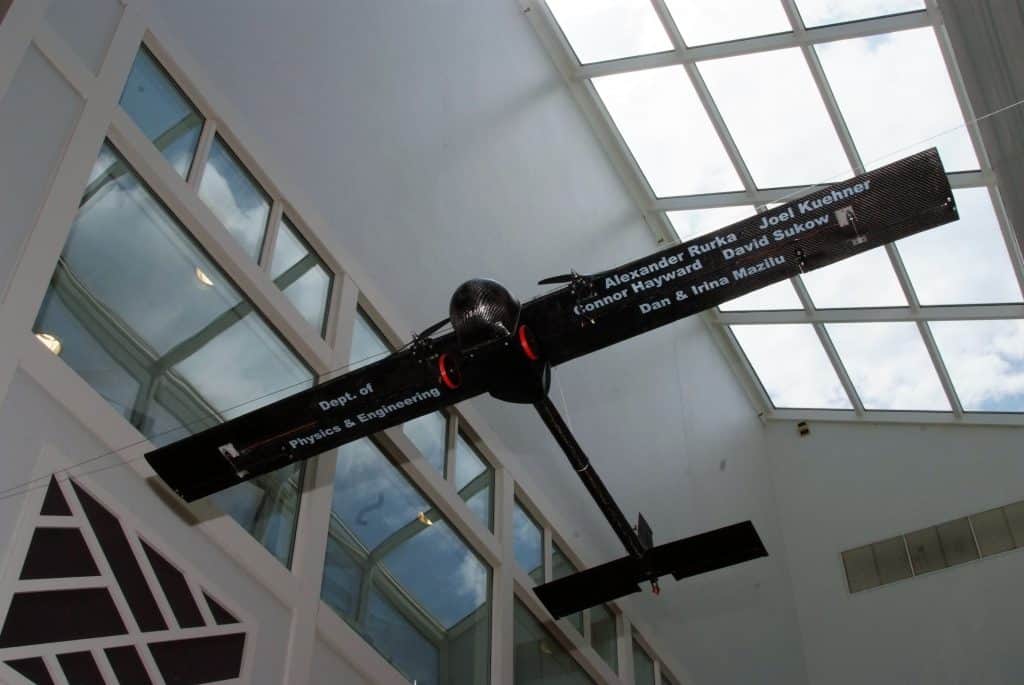Design/Build/Fly Students test their skills for an engineering competition
“Not only did we get to be more experienced working with the materials to build the airplanes, but the best lessons I got were how to build the team and organize labor to most efficiently meet the deadlines.”
For the past few years, the 20-foot-long Pteranodon suspended from the ceiling of the Science Center’s Great Hall has been flying solo. No longer. Jumping ahead a few epochs, the latest addition to the atrium is a plane.
So why a plane? Last fall Alexander Rurka was looking to participate in an engineering competition. A Google search landed on the Cessna/Raytheon Missile Systems Student Design/Build/Fly competition organized by the American Institute Of Aeronautics and Astronautics Foundation. “This one seemed to be the best in terms of its professional affiliations, the number of competitors and level of organization,” said Rurka.
Although Rurka headed up the project, about 15 to 20 students participated, each with different levels of involvement. “The General Flyers club, created to satisfy one of the competition requirements, is composed primarily of physics-engineering majors,” he said. “However, we did have a number of first-years who were undecided.” The group designed and fabricated an unmanned, electric-powered, radio-controlled aircraft to best meet the competition’s specified mission profile.
The rules were complex, and involved scoring the aircraft on a number of criteria. “The ultimate goal was to design and build two aircraft,” explained Rurka. “One airplane, the production airplane, had to be able to fly a 32-fluid-ounce Gatorade bottle around a race course. The second plane, the manufacturing airplane, had to be able to transport the production aircraft. The idea was to simulate the logistical processes airplane manufacturers go through when deciding how to build and deliver an airplane to a client. Do you ship the plane in a lot of small pieces or a few big pieces? We had to design the production airplane to meet some criteria and the transport aircraft to most efficiently ship the production airplane.”
Joel Kuehner, chair of the Physics-Engineering Department, is beyond delighted not only with how the project turned out, but also with what students learned during the building process. “Alexander was really the main force behind the build,” said Kuehner. “My role was to stand back and cheerlead. Over the past couple of years, he had built some radio-controlled aircraft, and came back last fall wanting to build a more involved project. He had all the expertise and brought the students together. He plans to enter another design-build-fly competition this academic year, and now he has a tangible, physical object to show students who are interested in joining the group.”
“Designing the airplanes wasn’t too hard,” Rurka said. “But building the production aircraft proved to be a large undertaking. These planes are big and require a lot of labor. One of our biggest challenges was meeting the competition’s deadlines (there are certain stages over the course of the year) while also having to meet school and athletic obligations.”
Many of the parts were ordered over the internet, but others were fabricated in W&L’s IQ Center. “The most expensive components are the motors, the servos to control the flaps and the radio transmitter,” said Kuehner. “But all in all, the cost was less than $1,000. For the actual build, Alexander was the main person who knew how to construct the aircraft, so he taught many of the other members. They used the 3-D printers to create molds that they could shape the carbon fiber in. Without access to the IQ Center, they would have had to sand the pieces into the shape they wanted, which is dangerous and time-consuming.”
Rurka summed up the project’s rewards. “We learned a ton. Not only did we get to be more experienced working with the materials to build the airplanes, but the best lessons I got were how to build the team and organize labor to most efficiently meet the deadlines. I would say that other students learned a lot about the manufacturing process for a large project. These lessons can apply to many other disciplines of engineering.”


You must be logged in to post a comment.